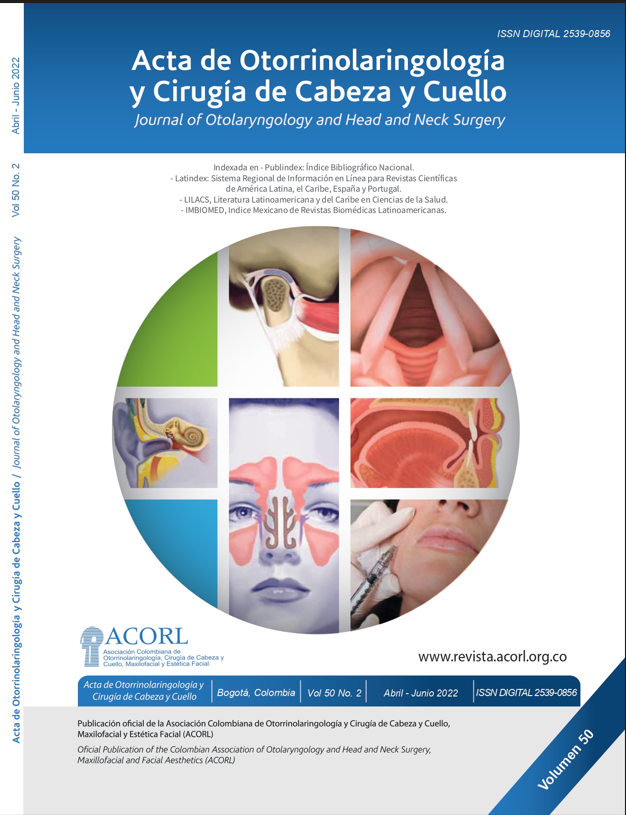Pulsatile tinnitus associated with shunt arteriovenous of dural origin: case report
Main Article Content
Abstract
Tinnitus is a commun entity, as it’s pulsatile characteristics, it’s important to identify
its etiology given the risk and morbidity that entails, such as tumors of vascular
origin or arteriovenous malformations. Objective: to describe the clinical case of a
patient with pulsatile tinnitus associated with an arteriovenous shunt of dural origin,
this patient received endovascular treatment. Results: To show the clinical followup
and endovascular findings of a patient with pulsatile tinnitus with arteriovenous
malformation who required endovascular treatment, the patient shows resolution
of symptoms in the follow-up at 18 months. Discussion: The importance of studying
patients with pulsatile tinnitus lies in determining possible causes of vascular
origin that explain their symptoms, wich’re mostly not evident in the initial evaluation.
Conclusion: Making an adequate diagnosis allows optimizing the treatment
of each patient, in pulsatile tinnitus associated with arteriovenous shunts, selective
embolization’s usually successful and safe, allowing the symptoms to be completely
resolved.
Downloads
Article Details

This work is licensed under a Creative Commons Attribution-ShareAlike 4.0 International License.
Este artículo es publicado por la Revista Acta de Otorrinolaringología & Cirugía de Cabeza y Cuello.
Este es un artículo de acceso abierto, distribuido bajo los términos de la LicenciaCreativeCommons Atribución-CompartirIgual 4.0 Internacional.( http://creativecommons.org/licenses/by-sa/4.0/), que permite el uso no comercial, distribución y reproducción en cualquier medio, siempre que la obra original sea debidamente citada.
eISSN: 2539-0856
ISSN: 0120-8411
References
1. Zenner HP, Delb W, Kroner-Herwig B, Jager B, Peroz I, Hesse G, et al. A multidisciplinary systematic review
of the treatment for chronic idiopathic tinnitus. Eur Arch Otorhinolaryngol. 2017;274(5):2079-2091. doi: 10.1007/
s00405-016-4401-y
Cima RFF, Mazurek B, Haider H, Kikidis D, Lapira A, Noreña A, et al. A multidisciplinary European guideline for tinnitus:
diagnostics, assessment, and treatment. HNO. 2019;67(Suppl1):10-42. doi: 10.1007/s00106-019-0633-7
In ‘t Veld M, Fronczek R, de Laat JA, Kunst HPM, Meijer FJA, Willems PWA. The Incidence of Cranial Arteriovenous Shunts
in Patients With Pulsatile Tinnitus: A Prospective Observational Study. Otol Neurotol. 2018;39(5):648-653. doi: 10.1097/
MAO.0000000000001767
Chari DA, Limb CJ. Tinnitus. Med Clin North Am. 2018;102(6):1081-1093. doi: 10.1016/j.mcna.2018.06.014
Cunnane MB. Imaging of Tinnitus. Neuroimaging Clin N Am. 2019;29(1):49-56. doi: 10.1016/j.nic.2018.09.006
Hofmann E, Behr R, Neumann-Haefelin T, Schwager K. Pulsatile tinnitus: imaging and differential diagnosis. Dtsch Arztebl Int.2013;110(26):451-8. doi: 10.3238/arztebl.2013.0451
Reardon MA, Raghavan P. Venous Abnormalities Leading to Tinnitus: Imaging Evaluation. Neuroimaging Clin N Am.
;26(2):237-45. doi: 10.1016/j.nic.2015.12.006
Miller TR, Serulle Y, Gandhi D. Arterial Abnormalities Leading to Tinnitus. Neuroimaging Clin N Am. 2016;26(2):227-36. doi:10.1016/j.nic.2015.12.002
Serulle Y, Miller TR, Gandhi D. Dural Arteriovenous Fistulae: Imaging and Management. Neuroimaging Clin N Am.
;26(2):247-58. doi: 10.1016/j.nic.2015.12.003
Zyck S, De Jesus O, Gould GC. Dural Arteriovenous Fistula. [actualizado 9 de mayo de 2022]. En: StatPearls [Internet].
Treasure Island (FL): StatPearls Publishing; 2022. Disponible en: https://www.ncbi.nlm.nih.gov/books/NBK532274/
Mulholland CB, Kalani MYS, Albuquerque FC. Endovascular management of intracranial dural arteriovenous fistulas. Handb Clin Neurol. 2017;143:117-123. doi: 10.1016/B978-0-444-
-9.00011-4
Hébert S, Canlon B, Hasson D, Magnusson Hanson LL,Westerlund H, Theorell T. Tinnitus severity is reduced with
reduction of depressive mood--a prospective population study in Sweden. PLoS One. 2012;7(5):e37733. doi: 10.1371/journal.pone.0037733

